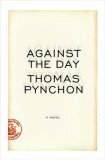Reading “Against the Day,” by Thomas Pynchon
Posted in Reading, Books on March 9th, 2007 by Eric Franklin
3 months, that’s how much of my life Thomas Pynchon’s new novel “Against the Day” absorbed in the reading; months representing times of complete mental pre-occupation (and often, truth be told, confusion) blocking most other artistic pursuits, certainly the ability for me to read other fiction.
In the end, was it all worth it? Absolutely.
How does one go about reading Pynchon?
My friends know I’m a bit of Pynchon fiend, and ask this question frequently. Many embark on the journey - few finish. Why?
Through the course of reading all of Pynchon’s works, I’ve learned to appreciate the level of engagement required to extract value from it and to understand that I’m going to miss a lot the first time through any of his books. That’s the way it is. His novels are just different. Any authorial intent generally occurs at a space removed from the narrative via recurring themes and complex systems acting upon the characters. It takes a while to get to where you can think abstractly about the characters you’re following and what they represent. Pynchon’s approach is expansive, explosive, ornate, and nearly always disorienting. I’ve found the only way for me to acheive any form of comprehension is to take the whole thing down and then puzzle over the “why” a bit later.
Initially, it is necessary to just keep reading. Momentum is the only thing of importance. Pay little heed to how much detail you’re missing (and much of the detail will fly right over your head). Take what you can, as you can, keeping the pages turning or else you’ll find yourself deep down “the rabbit hole” exploring one of many endless diversions. Eventually, I promise, the vision of the whole, quirky as it may be, will become more focused, the work more rewarding, but this is later. Plow straight through. Read the vignettes, appreciate them for tiny little artistic works they are, but set your vector onwards or you’ll never finish.
What is the Plot?
Like most Pynchon novels, certainly all the big ones, “the plot” is come upon very gradually (and at that level of removal I discussed above). I really like the analogy used by Jim Ruland in his review where he describes how the plot works:
When we open a novel we expect to be presented with a narrative. Even if the subject matter is long or short, familiar or foreign, compact or unruly, the expectation is that the writer will manage the material in a way that allows a story to be expressed. Pynchon does not follow these rules. If most novels are like nature narratives on the Discovery channel, Pynchon’s are like long shots of ants scurrying about in an ant farm; at first their antics seem utterly random, but the more one watches, the deeper the suspicion that the participants in the drama are communicating with one another in meaningful ways. To put it another way, the organizing principle of the modern novel is the family; Pynchon is interested in systems.
For an actual description of the plot, I think Louis Menand’s description of the plot in his review at The New Yorker said it the most simply:
The book is set in the period between 1893 and around 1920, and this is the plot: An anarchist named Webb Traverse, who employs dynamite as a weapon against the mining and railroad interests out West, is killed by two gunmen, Deuce Kindred and Sloat Fresno, who were hired by the wicked arch-plutocrat Scarsdale Vibe. Traverse’s sons—Kit, a mathematician; Frank, an engineer; and Reef, a cardsharp and ladies’ man—set out to avenge their father’s murder. (Webb also has a daughter, Lake, but she takes up with one of the killers.) This story requires a thousand and eighty-five pages to get told, or roughly the number of pages it took for Napoleon to invade Russia and be driven back by General Kutuzov. Of course, there are a zillion other things going on in “Against the Day,” but the Traverse-family revenge drama is the only one that resembles a plot—that is, in Aristotle’s helpful definition, an action that has a beginning, a middle, and an end.
Why read something like this?
I read Thomas Pynchon because the stunningly virtuosic prose and nuanced storytelling always leave me wanting more. The more I read, the more time I spend with his work, the more rewarding it becomes. This is true of very few authors.
I’ll leave you with one of my favorite brief passages. I could have picked any of hundreds, but this is the one that caught my eye:
And then one of those silences fell, and a curious thing had happened to time, for although they were the same people they had been when he had stepped on board the S.S. John of Asia last year, at the same time they were two entirely different people who had no business being in the same city together let alone the same room, and yet whatever it was between them was deeper now, the stakes were higher, the danger of how much there was to lose terribly, incontrovertibly clear. [876]
I’d be interested to see any favorite quotes any of you would like to submit to the comments. Also, let me know if there’s something you’d like me to specifically explore further in this book. I don’t mind diving back in.
Resources:
“Against the Day” Pynchon Wiki
Liveblogging forum for readers
Reviewers who get it right:
“Remains of Against the Day” - Jim Ruland’s review on The Elegant Variation
“Do the Math: Thomas Pynchon Returns” - Louis Menand at The New Yorker